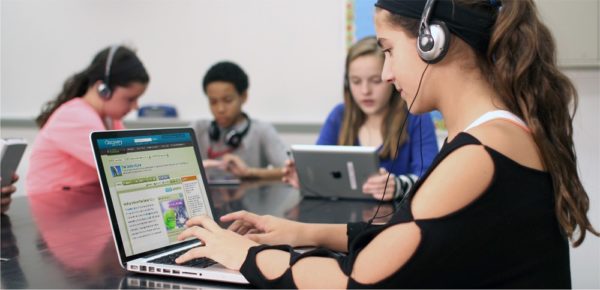Early digital textbook adopters share their pros and cons
Ed. note: We’re counting down the top stories of 2015 based on popularity (i.e. website traffic) to No. 1 on Dec. 31. We ran this feature on the challenges and opportunities of going digital early on — Jan. 28 to be exact — and in our January print edition. Writer Mary Axelson’s reporting was engrossing, and her case studies struck a chord with readers: While the original story ran across four pages, an unusually-above average number of you read it all the way to the end.
 It has been nearly three years since the FCC and Education Secretary Arne Duncan rolled out the Digital Textbook Playbook and challenged schools to go digital within five years. It’s safe to say schools are not there yet. While going digital looks certain, arrival in two years looks doubtful.
It has been nearly three years since the FCC and Education Secretary Arne Duncan rolled out the Digital Textbook Playbook and challenged schools to go digital within five years. It’s safe to say schools are not there yet. While going digital looks certain, arrival in two years looks doubtful.
The potential benefits for schools transitioning to digital curriculum—specifically, replacing their print textbooks with digital ones—remain compelling. As schools move to the Common Core, and Pluto shifts in and out of planetary status, information can be updated on the fly. Interactive quizzes, comments, and discussions live within the text itself. The addition of video, audio and interactivity allows for multi-modal, personalized, accessible and interactive learning; it’s lightweight for backpacks; and there are cost savings down the road from not printing.
Of course, widespread adoption relies on a robust infrastructure. Wireless bandwidth must be able to handle the load, and filtering must let advanced material through. Students need reliable devices at school and home, and the content needs to be designed for whatever platform they might have. Importantly, teachers need time to learn a new way of running a classroom.
Here, three early adopters of digital textbooks share their experiences, from conveniences and triumphs to pitfalls and setbacks. Their stories provide a glimpse into the present, still-evolving world of digital textbooks, and a hint into where it may be headed.
The Fairfax Learning Curve
Virginia’s Fairfax County Public Schools, with 12,000 students per grade level, is a pioneer in the digital textbooks space. Craig Herring, the director of Prek-12 curriculum and instruction, explains that they started using some Pearson online textbooks in 2009, back when they were essentially PDF versions of the printed books. The next year, they flipped that model by buying online social studies books with some hardcopy backups. Those online textbooks included some new features, and they rolled that out to all grades, 7-12, in 2011.
Next page: The huge mistake that nearly derailed Fairfax’s program
There were “hiccups,” Herring says, but nothing like what happened when they abruptly shifted to the new math books, which relied on an internet connection to the district’s website, which ended up overloading their servers.
“I don’t know that anybody anticipated how much traffic our division would bring to the site,” explains Rose Moore, mathematics coordinator for the district. Three years later, Fairfax now has sufficient infrastructure to support the load, as well as a help desk maintained by Pearson. Importantly, help is available when kids start homework late at night. But the district continues to search for a way to relieve teachers of the cumbersome task of giving each student access to their online accounts, since they have not yet found a way to seamlessly integrate the process with their SIS.
The district uses a BYOD approach to grant students access, and supplements that by letting kids check out devices and hotspot cards for wifi access. They work diligently to ensure access in high poverty schools. One school, upon device checkout, supplies maps and tours of free, neighborhood wifi spots such as the library, McDonalds, and Starbucks. Even so, home access is not guaranteed. Herring tells that their advance survey asked if the family had a computer at home, but a “yes” failed to account for multiple kids needing access to multiple textbooks. “Generally, the older kid would win out,” says Herring, “The middle school student wouldn’t be able to get on to do their math homework because it was being used by the senior studying for AP.”
Generally, Herring advises districts look into short-term contracts of no more than two to three years. New options are on the market from their publisher, but Fairfax remains locked in to a 6-year contract with an old version. The district has also discovered the importance of defining technical standards for contracts.
“Everything is changing so quickly,” says Herring. “I’m not sure the future is these big basal textbooks. We develop a lot of curriculum ourselves…and we like pulling from other places.” As he watches teachers, he realizes, “They’d rather pick and choose.” Herring also advises giving teachers substantial time to learn the features and resources of a new, digital platform before sharing it with students.
Copious Copia
Copia is among the companies responding to a mashable culture. The company offers schools and colleges the ability to choose bits and pieces from a wide array of partners, including Macmillan, McGraw Hill, Houghton Mifflin, Pearson, Random House, and Simon and Schuster. They offer textbook publishers a platform with instant interoperability and digital features such as the ability for teachers to embed in-class discussions, quizzes, and activities within the text and to track student usage and achievement.
Cross platform reliability is a work in progress. In an attempt to avoid the technical glitches that come with digital materials, some districts have insisted that all digital content be compliant with the interoperability standards of the IMS Global Learning Consortium. Copia aims to be IMS compliant by the beginning of the next school year.
Advanced Placement courses are the focus of a small, new Copia/iPad pilot at Islip High School in New York. Wayne Mennecke has brought the Copia/iPad pilot to two sections of AP Biology and one section of Biochemistry. Explains Mennecke, “I view their use right now as I would lab equipment. Not every lesson calls for every piece of lab equipment, but when the opportunity is right, students can and should take advantage of the tablets as a resource.” Mennecke has used some apps that deal with the concepts of mitosis and cell division, and his students are reading selections from The Immortal Life of Henrietta Lacks and The Sports Gene.
Rahana Schmalacker has used Copia for poems and short stories with her AP literature students. They will soon begin their first digital novel, the classic warning of mechanization, Frankenstein. She was surprised to find that students do not find the technology or content particularly exciting. “Some are more comfortable with paper,” she explains. But students like the convenience of clicking for definitions, and Schmalacker likes the ability to guide reading with embedded questions. The devices don’t go home with the students, and both teachers say that this limits their value.
Copia began with a significant Australian project, LearningField, and their U.S. projects are growing larger very soon. According to a November memo from the state Superintendent of Public Instruction, Virginia will pilot a statewide digital textbook marketplace, where districts can purchase approved digital textbooks and other learning resources. They are starting by inviting foreign language teachers (which will have textbooks with sound) and AP classes to volunteer for using the marketplace’s portal, developed by Copia. Fairfax does not yet know how this will impact their use of digital textbooks.
Three Years of Discovery
Rock Hill Schools in South Carolina ran its first pilot of the Discovery Education Science Techbook in grades K-5 during the 2012-2013 school year using the district’s iRock program to provide in-school iPads (families can take out an insurance policy to bring them home). The district expanded to Discovery Education’s Social Studies Techbook in all middle school classrooms in 2013 and recently added math.
Gail Steffensen, who teaches fourth grade at Mount Holly Elementary in Rock Hill Schools, is in her third year of using the techbook. The curricular abundance, which includes experiments and games, allows her to let advanced students work on something additional, and she uses those resources to fill-in missing background information for other students. Like Schmalacker, she is a fan of the quick access to definitions for unfamiliar vocabulary, and she has found that audio paired with text can boost comprehension and skills for new readers.
And her students, she says, are also notably more engaged with iPads than worksheets, a bit of anecdotal evidence that seems to support a recent study by Merola Research conducted at the district, which found that 21 percent of fourth-grade students using the Science Techbook scored at or above the exemplary level on the Science PASS, compared to only 15 percent of students who weren’t using these resources..
Rock Hill elementary schools do not yet have a comprehensive set of digital resources for social studies, so Steffensen recently spent many hours vetting twenty videos for a unit on the trade triangle of slavery. In the future, she would like access to a comprehensive curriculum in all subjects that would gather grade appropriate videos, photos, and documents, but, she adds, she would continue to watch, read and listen to anything before bringing it into her classroom.
Of course, “there are times when something crashes and it doesn’t work,” she says, but adds that she’s not solely reliant on the digital books for her lessons. “Teachers always have to have a backup plan.”
Mary Axelson is a contributing writer for eSchool News.
- TC- What student choice and agency actually looks like - November 15, 2016
- What student choice and agency actually looks like - November 14, 2016
- App of the Week: Science sensor meets your smartphone - November 14, 2016


